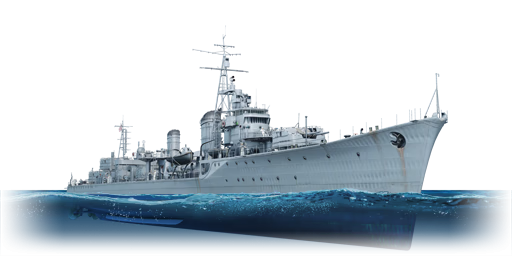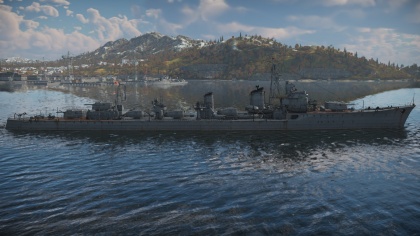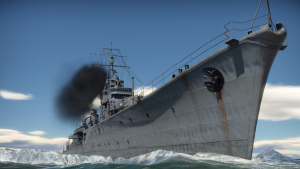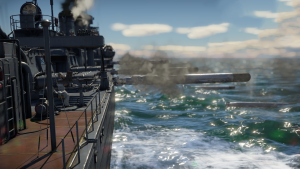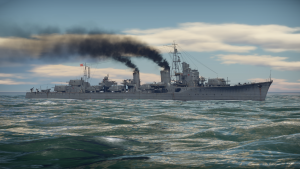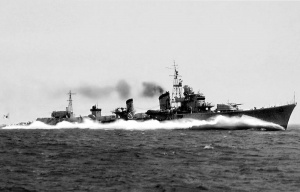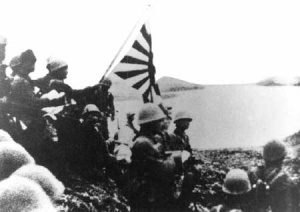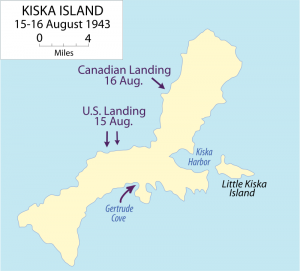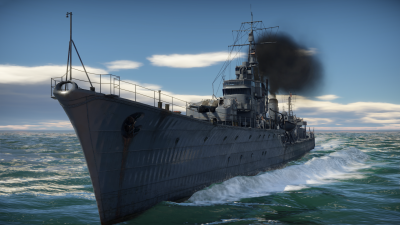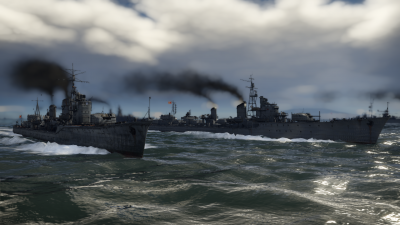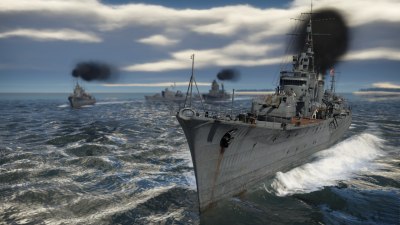Difference between revisions of "IJN Shimakaze"
(→History) |
(→1943: July complete(?)) (Tag: Visual edit) |
||
| Line 156: | Line 156: | ||
Under this Maru 4 there would be 3 modernized destroyer types | Under this Maru 4 there would be 3 modernized destroyer types | ||
| + | |||
*Type A: ''Kagerō''-class, [[Yugumo (Family)|''Yūgumo''-class]] - Regular destroyers <small>(further expansion Of Maru 3)</small> | *Type A: ''Kagerō''-class, [[Yugumo (Family)|''Yūgumo''-class]] - Regular destroyers <small>(further expansion Of Maru 3)</small> | ||
*Type B: ''Akizuki''-class - Dedicated anti-air destroyers | *Type B: ''Akizuki''-class - Dedicated anti-air destroyers | ||
| Line 167: | Line 168: | ||
With the Maru 4 being specified and funded, construction of ''Shimakaze'' started in 1941 at the Maizuru Naval Arsenal. She was to be built as a high speed ship, heavily armed with torpedoes to excel at her role as a destroyer in the purpose of torpedo-combat. | With the Maru 4 being specified and funded, construction of ''Shimakaze'' started in 1941 at the Maizuru Naval Arsenal. She was to be built as a high speed ship, heavily armed with torpedoes to excel at her role as a destroyer in the purpose of torpedo-combat. | ||
| − | ''Shimakaze''<nowiki />'s hull was essentially an elongated Type A ([[Yugumo (Family)|''Yūgumo''-class]]) destroyer hull with the same main armament but having an additional {{Annotation|7.62 m|25 ft}} of added length allowing for a third torpedo launcher. But because she was already quite top-heavy like other Japanese destroyers, her additional length was only able to cover an additional torpedo launch turret and AA mounts, but would become too heavy if she carried an additional reload for her torpedoes at sea. | + | ''Shimakaze''<nowiki/>'s hull was essentially an elongated Type A ([[Yugumo (Family)|''Yūgumo''-class]]) destroyer hull with the same main armament but having an additional {{Annotation|7.62 m|25 ft}} of added length allowing for a third torpedo launcher. But because she was already quite top-heavy like other Japanese destroyers, her additional length was only able to cover an additional torpedo launch turret and AA mounts, but would become too heavy if she carried an additional reload for her torpedoes at sea. |
She was initially planned to carry 2 x 7 tube torpedo launchers, but due to the weight of the turret it would be impossible to hand crank the turret in case of a power outage and with this she got 3 x 5 tube torpedo launchers instead. | She was initially planned to carry 2 x 7 tube torpedo launchers, but due to the weight of the turret it would be impossible to hand crank the turret in case of a power outage and with this she got 3 x 5 tube torpedo launchers instead. | ||
| Line 179: | Line 180: | ||
===Service History=== | ===Service History=== | ||
====1943==== | ====1943==== | ||
| + | |||
;May | ;May | ||
| + | |||
As she left port on the 10th, she would be handed over to the navy and assigned to the 11th destroyer squadron, 1st fleet. Desron 11 was a dedicated squadron to train crew on new & repaired destroyers before they would be sent to the frontline waters. | As she left port on the 10th, she would be handed over to the navy and assigned to the 11th destroyer squadron, 1st fleet. Desron 11 was a dedicated squadron to train crew on new & repaired destroyers before they would be sent to the frontline waters. | ||
;July | ;July | ||
| − | |||
| − | During 1943, the captured islands of Attu and Kiska were to be taken back by allied forces as they were captured during the start of the pacific war by Japan, the American recapture of these 2 islands, started of with taking the most east island of Attu (Operation Landcrab) which would be less militarily developed compared to Kiska which had a port, airfield and other military installations, creating a naval blockade and cutting off the island of Kiska completely from Japanese reach. | + | ''Shimakaze'''s first assignment was to escort and cover the evacuation of Japanese soldiers & personnel from Kiska, Aleutian Islands as part of the Japanese Operation One Sword「{{Annotation|ケ=Ke}}」 ({{Annotation|ケ号作戦=Ke gōsakusen}}). Where she together with Desron 2 she would assigned to after fully being trained in Desron 11. |
| + | [[File:JapaneseKiska.jpg|left|thumb|On June 6, 1942, the Imperial Army occupied Kiska and raised the flag.]] | ||
| + | During 1943, the captured islands of Attu and Kiska were to be taken back by allied forces as they were captured during the start of the pacific war by Japan, the American recapture of these 2 islands, started of with taking the most east island of Attu (Operation Landcrab) which would be less militarily developed compared to Kiska which had a port, airfield and other military installations, creating a naval blockade and cutting off the island of Kiska completely from Japanese reach. In May the Americans together with Canadians would be victorious in the Battle of Attu at a great cost for both sides which would lead to poor decision-making towards the capture of Kiska (Operation Cottage). | ||
| − | + | Even though Kiska was cut-off for the Japanese making it no longer defensible, and Japan needed all the men they could use, wouldn't allow to turn it into Attu 2. With this command greenlit the evacuation of Kiska. | |
| − | + | ''Shimakaze'' would take part of the evacuation as flagship of the screening force. The initial evacuation run which was planned for 7 - 17 July, but was aborted due the bad weather on the 15th. | |
| + | |||
| + | {{Break}} | ||
| − | '' | + | [[File:Kiska Landings.png|thumb|Allied ''Operation Cottage'' landing sites]] |
| + | For the 2nd attempt which got planned for 22 July - 1 August, weather conditions seemed to be very similar as those during the first evacuation run since the first day but command was losing time, fuel and patience. At first, command wanted weather to clear up, but decided to rush it through the weather regardless before they lost too much time due the vocal opinion of Shigenori Kami, captain of the ''Tama'', lead ship of the operation. | ||
| − | While | + | The fleet was preparing to rush into Kiska bay without waiting for their fueling party to top them off outside the USS patrol area, the cruiser ''Abukuma'' pushed her fuel reserve and refueled her accompanying destroyers. In the midnight of the 29th, the fleet ran towards Kiska bay following the shadow of the island and passing from the west to evade any American patrols from the open south. While arriving at Kiska Bay, there was information on a detected vessel, unknown what it was, ''Shimakaze'''s radar detected it as well, which might have been a USS destroyer on patrol. Detecting an enemy, Her crew was excited for her first naval engagement at 13:00, she fired several torpedoes at the shadow of the enemy vessel together with the cruiser ''Abukuma'' who spotted it first and fired four torpedoes. But this target wasn't an allied vessel, but Little Kiska Island which appeared to look like a ship in this very thick fog. |
| − | The whole island garrison would be fully withdrawn to the island of Paramushir in-between July 31 & August 1, fully returning 2518 navy crew, 2669 army men and 30 others resulting in a total of 5183 men. | + | The fleet would anchor at Kiska Harbor at 13:40 where at the time there was a temporary clear fog in the bay. An approximate 5,200 Kiska island garrison members who had been waiting for their evacuation immediately embarked the fleet and leaving behind their Type 38 rifles which would be grossly outdated and save on weight while doing so. The whole garrison would be fully accommodated in the short time of 55 minutes with help of [[Daihatsu-class Landing Craft|Daihatsu Landing Crafts]]. The fleet would leave Kiska at full speed (28 knots) surrounded once more by the deep fog they arrived. In a detailed report, the amount of men accommodated on ships was as following: |
| + | {| class="wikitable mw-collapsible mw-collapsed" | ||
| + | ! colspan="6" |Recovered men | ||
| + | |- | ||
| + | !Cruisers | ||
| + | !Men | ||
| + | ![[Yugumo (Family)|''Yugumo''-class]] | ||
| + | !Men | ||
| + | !Other | ||
| + | !Men | ||
| + | |- | ||
| + | |''Abukuma'' | ||
| + | |1,202 | ||
| + | |[[IJN Yugumo|''Yugumo'']] | ||
| + | |479 | ||
| + | |''Hibiki'' | ||
| + | |418 | ||
| + | |- | ||
| + | |''Kiso'' | ||
| + | |1,189 | ||
| + | |''Kazagumo'' | ||
| + | |478 | ||
| + | | | ||
| + | | | ||
| + | |- | ||
| + | | | ||
| + | | | ||
| + | |''Akigumo'' | ||
| + | |478 | ||
| + | | | ||
| + | | | ||
| + | |- | ||
| + | | | ||
| + | | | ||
| + | |''Asagumo'' | ||
| + | |468 | ||
| + | | | ||
| + | | | ||
| + | |- | ||
| + | | | ||
| + | | | ||
| + | |''Usugumo'' | ||
| + | |476 | ||
| + | | | ||
| + | | | ||
| + | |- | ||
| + | | colspan="2" |Total | ||
| + | | colspan="4" |5,183 | ||
| + | |} | ||
| + | The whole island garrison would be fully withdrawn to the island of Paramushir in-between July 31 & August 1, fully returning 2518 navy crew, 2669 army men and 30 others resulting in a total of 5183 men. Because of the fog covering the withdrawl force, the success of Operation Ke would be dubbed as a Miracle Operation ({{Annotation|奇跡の作戦=Kiseki no sakusen}}) | ||
| − | Even though recon reported diminishing island movement, damage not being repaired, less and less anti-aircraft fire and on July 28 radio signals from Kiska completely | + | Even though Allied recon reported diminishing island movement, damage not being repaired, less and less anti-aircraft fire and on July 28 radio signals from Kiska completely going silent. American forces still proceeded to invade the island being fully prepared to fight Japanese soldiers digged into the mountains. |
| − | As U.S and Canadian forces landed on opposite shores, once meeting, mistook each other for Japanese and sporadic friendly fire occurred, together with Japanese booby-traps and the [[Fletcher (Family)|USS ''Abner Read'' (DD-526)]] hitting a stray sea-mine, would lose a large chunk of its stern. All this would leave the allies with around 200 men dying, and 400 more casualties. | + | As U.S and Canadian forces landed on opposite shores, once meeting, mistook each other for Japanese and sporadic friendly fire occurred, together with Japanese booby-traps and the [[Fletcher (Family)|USS ''Abner Read'' (DD-526)]] hitting a stray sea-mine, who would lose a large chunk of its stern. All this would leave the allies with around 200 men dying, and 400 more casualties against a force of null. |
;August | ;August | ||
| + | |||
On July 5, ''Shimakaze'' arrived at Paramushiro after her July operations near the Aleutian Islands, she would escort the cruiser ''Maya'' to Yokosuka, arrive on 6 August, where she then docked for maintenance. | On July 5, ''Shimakaze'' arrived at Paramushiro after her July operations near the Aleutian Islands, she would escort the cruiser ''Maya'' to Yokosuka, arrive on 6 August, where she then docked for maintenance. | ||
;September | ;September | ||
| + | |||
Once done with maintenance on the 15th she would escort the cruisers ''Chokai'' and ''Maya'' to Truk. They would arrive the 20th and ''Shimakaze'' would escort the escort-carriers ''Chūyō'' and ''Taiyō'' back to Yokosuka the next day. | Once done with maintenance on the 15th she would escort the cruisers ''Chokai'' and ''Maya'' to Truk. They would arrive the 20th and ''Shimakaze'' would escort the escort-carriers ''Chūyō'' and ''Taiyō'' back to Yokosuka the next day. | ||
| − | 3 days later on way to Yokosuka, | + | 3 days later on way to Yokosuka on the 24th, ''Taiyō'' would be hit by a torpedo by the USS ''Cabrilla'', SS-288 (3 torpedo launches, 1 hit), and lost a propeller shaft. ''Shimakaze'' pulled 8 men that fell from the ship during the hit and ''Chūyō'' would tow her sister as she couldn't navigate on her own anymore. The ''Cabrilla'' wanted to attack the ''Chūyō'' as well to stop both ships from continuing but as ''Shimakaze'' launched a depth charge to scare off the submarine (Shimakaze reported it would sink), took evasive manouvers and lost sight of the ships after looking for them again. |
| + | |||
| + | While and after chasing the submarine, ''Shimakaze'' struck upon the destroyers ''Sazanami'' and ''Shiratsuyu'' and they joined the group to escort towards Yokosuka where they would arrive the 26th. | ||
<!-- | <!-- | ||
;October | ;October | ||
Revision as of 18:00, 23 December 2020
Contents
Description
The Shimakaze-class, IJN Shimakaze, 1944 is a squadron rank III Japanese destroyer
with a battle rating of 5.0 (AB/RB/SB). It was introduced during Update "Raining Fire".
General info
Survivability and armour
Shimakaze is an extended Yugumo-class hull which comparatvily gives her more crew and extra space & displacement for an additional torpedo launcher and other weight, but also higher crew count (+40 men). Additionally her survivability is further is aided by having ammunition stored deep underneath the water line, what ensures survival if faced with AP shells, and having torpedo turrets protected against fragmentation damage, though they are still one of the easiest components to damage on the ship.
That said though, comparing to the equivalents in its BR, the ship has a relatively low crew count, sailing just a 2/3 of the Leningrad men, in a short-range fights Shimakaze has to rely on her overwhelming firepower to take down the enemy before suffering overwhelming causalities herself. This can either be the use of her main armament, her plentyful arsenal of torpedoes and/or 25 mm's.
Mobility
Shimakaze is by far the fastest Japanese ship ever made, she could reach a top speed of 40,9 kn due her new experimental high temperature and pressure Kampon boilers that developed 79,240 shaft horsepower, powering a new type of turbine, which generated 50 percent more power than typical turbines used in previous destroyers.
| Mobility Characteristics | |||
|---|---|---|---|
| Game Mode | Upgrade Status | Maximum Speed (km/h) | |
| Forward | Reverse | ||
| AB | |||
| Upgraded | 93 | 31 | |
| RB/SB | |||
| Upgraded | 76 | 25 | |
Armament
Primary armament
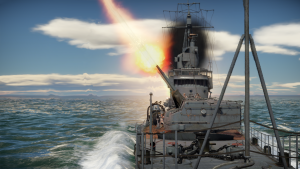
Shimakaze's primary guns are shared with Yugumo and Ayanami, offering the same capabilities and the same shell choice. Despite of being in a higher BR the ship stands a fair chance against its counterparts, though with increasingly challenging opponents and added care has to be put in an accurate gunnery and torpedoes play an even more important role in disposing opponents. But like her parallel predecessor (Yugumo-class), her main armament isn't her selling point at this BR.
Secondary armament
Unlike other early refits of Japanese destroyers, which have very few anti-air defense, the Shimakaze is refitted in her 1944 fit, which gives her well enough air cover at semi-close ranges and desimates smaller patrol vessels within 2km range.
- Universal belts: good balance between firepower and tracer contents, useful for newcomers to the Japanese 25 mm autocannon.
- APT belts: Full of AP shells, good against boats but you might not meet lots of them in destroyer.
- HEI belts: Trades tracer rounds for extra firepower, harder to aim but very good at knocking out aircraft.
Anti-aircraft armament
The Shimakaze has a single 13.2 mm HMG on the stern. Her 25 mm's are responsible for for air cover along with the 13 mm, but can't be manually controlled together with the 25 mm's at the same time.
Torpedo armament
Shimakaze uses the Type 93 Model 3 torpedoes, which have a reduced range of 15 km compared to the standard 20 km Type 93 Model 1 found on other Japanese ships. While not gaining any speed advantage, it does gain an even larger warhead: ~1000 kg of TNT instead of ~600, which makes it possible to sink nearly any destroyer with a single hit.
On top of having one of the best torpedoes, she racks a total of 15 torpedoes she can fire all at once due her lengthened hull compared to the Yugumo-class allowing for heavier quintuple launchers, and an extra 3rd torpedo turret due the added buoyancy.
| Torpedo Characteristics | |||||||
|---|---|---|---|---|---|---|---|
| Mass (kg) | Maximum speed in water (km/h) | Travel distance (km) | Depth stroke (m) | Arming distance (m) | Explosive type | Explosive mass (kg) | TNT equivalent (kg) |
| 2,800 | 91 | 15.00 | 1 | 50 | Type 97 | 780 | 998.4 |
Special armament
Without the presence of submarines, the usage of depth charges is very situational. If using the depth charges that drop off stern racks, there is no reason to use any depth charge activation time setting above the minimum 3 seconds, since higher times means the depth charge will sink further, and thus away from the target. With a fast boat, sailing up right next to a slower target and dropping the depth charges can lead to some success.
The depth charges mounted on depth charge throwers are even more situational. They cannot be aimed and have a long flight time, making them difficult to use against moving targets. Their detonation times also cannot be changed, detonating 3 seconds after hitting the water. They can be used to hit an enemy behind cover, though as with other depth charge uses, this is extremely situational.
Usage in battles
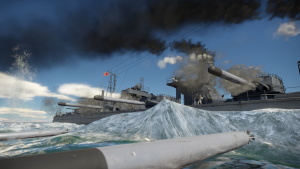
The Shimakaze is one of the most formidable destroyers Japan can offer, owing largely to its outstanding torpedo armament of 3 quintuple launchers and only beaten by Tashkent as 2nd fastest ship in-game.
Otherwise, she has a well-rounded mix of survivability and firepower, lagging behind slightly due to the lack of AP ammunition options, making it cannon fodder for most cruisers if the manoeuvrability isn't made use of. On the contrary, cruisers only have to worry about the Shimakaze like any other Japanese destroyer for the arsenal of torpedoes that will most likely wall them off in a wave of torpedoes and sinking them instantly.
The Long Lance is among the best torpedo in game with excellent range, speed and explosive filler. Like all torpedo-centric destroyers, Shimakaze excels in Arcade Battles with the ability to re-spawn torpedoes mid-battle and is better than other Japanese destroyers which have a 2nd reload for torpedoes which takes a few seconds between torpedo bursts unlike the full burst the Shimakaze can do at once and instantly reload the full rack. Meanwhile in realistic battles torpedoes should be used sparing as you can't reload them out of the capture zone and only reloads one torpedo per torpedo turret.
Modules
| Tier | Seakeeping | Unsinkability | Firepower | |||
|---|---|---|---|---|---|---|
| I | Dry-Docking | Tool Set | 25 mm APT belt | |||
| II | Rudder Replacement | Fire Protection System | Smokescreen | 25 mm HEIT belts | Auxiliary Armament Targeting | 127 mm HE-TF |
| III | Propeller Replacement | Shrapnel Protection | Ventilation | Improved Rangefinder | Primary Armament Targeting | |
| IV | Engine Maintenance | New Pumps | Ammo Wetting | Bomb mortar | ||
Pros and cons
Pros:
- Fastest Japanese destroyer
- Good manoeuvrability
- Top speed of 93 / 76 km/h
- 3 quintuple torpedo launchers
- Can release 15 torpedoes at once
- Very deadly torpedoes (Type 93 Model 3)
- 127 mm guns have good ballistics
- 21 x 25 mm AA cannons with a lot of ammunition
Cons:
- Average Japanese destroyer turrets (Type 3 (127 mm))
- Slow turret traverse
- 127 mm guns have no AP (only HE and HE-DF)
- 127 mm guns are almost useless against air targets (due to slow traverse)
- Turrets tend to be taken out often
- 25 mm AA only effective at close range (max range about 3 km)
History
Shimakaze (島風, Island Wind) (Project N° F52; Hull N° 125) was a new end of the line experimental heavy destroyer which would be the lead ship this new class of C-Type destroyers.
She was built under the Maru 4 programme together with another 16 of her kind planned and long term plans of extending her class to 32 ships to form 4 destroyer squadrons. These ambitious plans would be dropped down to 8 in the Maru 5 programme and eventually her sister ships would all be cancelled and re-planned on 30 June 1942 to 8 x Yūgumo-class and 7 x Super Akizuki-class
Development
By 1939, the Imperial Japanese Navy had expanded massively with 3 Naval Armaments Supplement programmes and it wouldn't stop there. With their 4th Naval Armament Supplement programme (マル4計画, 第四次海軍軍備充実計画), otherwise known as Maru 4, they planned to expand their navy with an additional 80 warships and 75 Naval Air Groups costing 1.6 billion Japanese Yen.
Under this Maru 4 there would be 3 modernized destroyer types
- Type A: Kagerō-class, Yūgumo-class - Regular destroyers (further expansion Of Maru 3)
- Type B: Akizuki-class - Dedicated anti-air destroyers
- Type C: Shimakaze-class - High-end heavy duty destroyers
The top speed of any Japanese warship within the IJN went to a previous generation of Shimakaze (1920) coming from the Minekaze-class destroyers with a max speed of 40.7 knots, while all other destroyers were to be designed with a top speed of only 35 knots. After that the Navy was seeking to improve cruising speed yet keeping the possibility of armament and hull improvements open.
These demands arose after Japan abolished the Washington Naval Treaty and withdrew from the London Naval Treaty in 1938 and began the rapid modernization of their navy in both tonnage and equipment. Together with Japanese intelligence gathering information on the USN developing a new destroyer with a top speed of 38 knots or more and the new generation of American cruisers and battleships having a projected speed of 27-33 kn. With those reasons the Navy wanted to outshine the Americans by having faster ships and high power torpedoes which they already had developed.
Design
With the Maru 4 being specified and funded, construction of Shimakaze started in 1941 at the Maizuru Naval Arsenal. She was to be built as a high speed ship, heavily armed with torpedoes to excel at her role as a destroyer in the purpose of torpedo-combat.
Shimakaze's hull was essentially an elongated Type A (Yūgumo-class) destroyer hull with the same main armament but having an additional 7.62 m of added length allowing for a third torpedo launcher. But because she was already quite top-heavy like other Japanese destroyers, her additional length was only able to cover an additional torpedo launch turret and AA mounts, but would become too heavy if she carried an additional reload for her torpedoes at sea.
She was initially planned to carry 2 x 7 tube torpedo launchers, but due to the weight of the turret it would be impossible to hand crank the turret in case of a power outage and with this she got 3 x 5 tube torpedo launchers instead.
Her new experimental high temperature and pressure Kampon boilers which were designed further upon from the Kagerō-class, Amatsukaze that developed 79,240 shaft horsepower and would prove to be a very good combination with a new type of turbine would allow her to put out 50% more power compared to other destroyers.
Due to set-backs in the Pacific War, other priorities shifted the budget of the Maru 4 plan and less resources would be spent on more of the already expensive Type C destroyer. After many delays of the lead ship Shimakaze, her sister ships were cancelled and allocated to Type A & B destroyers instead. Shimakaze would finally leave port on the 10th May, 1943.
Shimakaze was one of the first Japanese ships to be equipped with a radar with her Type 22 radar due to her long time in port. This would be supplemented with a Type 13 radar in June 1944 together with an increase in 25 mm AA guns.
Service History
1943
- May
As she left port on the 10th, she would be handed over to the navy and assigned to the 11th destroyer squadron, 1st fleet. Desron 11 was a dedicated squadron to train crew on new & repaired destroyers before they would be sent to the frontline waters.
- July
Shimakaze's first assignment was to escort and cover the evacuation of Japanese soldiers & personnel from Kiska, Aleutian Islands as part of the Japanese Operation One Sword「{{{1}}}」 ({{{1}}}). Where she together with Desron 2 she would assigned to after fully being trained in Desron 11.
During 1943, the captured islands of Attu and Kiska were to be taken back by allied forces as they were captured during the start of the pacific war by Japan, the American recapture of these 2 islands, started of with taking the most east island of Attu (Operation Landcrab) which would be less militarily developed compared to Kiska which had a port, airfield and other military installations, creating a naval blockade and cutting off the island of Kiska completely from Japanese reach. In May the Americans together with Canadians would be victorious in the Battle of Attu at a great cost for both sides which would lead to poor decision-making towards the capture of Kiska (Operation Cottage).
Even though Kiska was cut-off for the Japanese making it no longer defensible, and Japan needed all the men they could use, wouldn't allow to turn it into Attu 2. With this command greenlit the evacuation of Kiska.
Shimakaze would take part of the evacuation as flagship of the screening force. The initial evacuation run which was planned for 7 - 17 July, but was aborted due the bad weather on the 15th.
For the 2nd attempt which got planned for 22 July - 1 August, weather conditions seemed to be very similar as those during the first evacuation run since the first day but command was losing time, fuel and patience. At first, command wanted weather to clear up, but decided to rush it through the weather regardless before they lost too much time due the vocal opinion of Shigenori Kami, captain of the Tama, lead ship of the operation.
The fleet was preparing to rush into Kiska bay without waiting for their fueling party to top them off outside the USS patrol area, the cruiser Abukuma pushed her fuel reserve and refueled her accompanying destroyers. In the midnight of the 29th, the fleet ran towards Kiska bay following the shadow of the island and passing from the west to evade any American patrols from the open south. While arriving at Kiska Bay, there was information on a detected vessel, unknown what it was, Shimakaze's radar detected it as well, which might have been a USS destroyer on patrol. Detecting an enemy, Her crew was excited for her first naval engagement at 13:00, she fired several torpedoes at the shadow of the enemy vessel together with the cruiser Abukuma who spotted it first and fired four torpedoes. But this target wasn't an allied vessel, but Little Kiska Island which appeared to look like a ship in this very thick fog.
The fleet would anchor at Kiska Harbor at 13:40 where at the time there was a temporary clear fog in the bay. An approximate 5,200 Kiska island garrison members who had been waiting for their evacuation immediately embarked the fleet and leaving behind their Type 38 rifles which would be grossly outdated and save on weight while doing so. The whole garrison would be fully accommodated in the short time of 55 minutes with help of Daihatsu Landing Crafts. The fleet would leave Kiska at full speed (28 knots) surrounded once more by the deep fog they arrived. In a detailed report, the amount of men accommodated on ships was as following:
| Recovered men | |||||
|---|---|---|---|---|---|
| Cruisers | Men | Yugumo-class | Men | Other | Men |
| Abukuma | 1,202 | Yugumo | 479 | Hibiki | 418 |
| Kiso | 1,189 | Kazagumo | 478 | ||
| Akigumo | 478 | ||||
| Asagumo | 468 | ||||
| Usugumo | 476 | ||||
| Total | 5,183 | ||||
The whole island garrison would be fully withdrawn to the island of Paramushir in-between July 31 & August 1, fully returning 2518 navy crew, 2669 army men and 30 others resulting in a total of 5183 men. Because of the fog covering the withdrawl force, the success of Operation Ke would be dubbed as a Miracle Operation ({{{1}}})
Even though Allied recon reported diminishing island movement, damage not being repaired, less and less anti-aircraft fire and on July 28 radio signals from Kiska completely going silent. American forces still proceeded to invade the island being fully prepared to fight Japanese soldiers digged into the mountains.
As U.S and Canadian forces landed on opposite shores, once meeting, mistook each other for Japanese and sporadic friendly fire occurred, together with Japanese booby-traps and the USS Abner Read (DD-526) hitting a stray sea-mine, who would lose a large chunk of its stern. All this would leave the allies with around 200 men dying, and 400 more casualties against a force of null.
- August
On July 5, Shimakaze arrived at Paramushiro after her July operations near the Aleutian Islands, she would escort the cruiser Maya to Yokosuka, arrive on 6 August, where she then docked for maintenance.
- September
Once done with maintenance on the 15th she would escort the cruisers Chokai and Maya to Truk. They would arrive the 20th and Shimakaze would escort the escort-carriers Chūyō and Taiyō back to Yokosuka the next day.
3 days later on way to Yokosuka on the 24th, Taiyō would be hit by a torpedo by the USS Cabrilla, SS-288 (3 torpedo launches, 1 hit), and lost a propeller shaft. Shimakaze pulled 8 men that fell from the ship during the hit and Chūyō would tow her sister as she couldn't navigate on her own anymore. The Cabrilla wanted to attack the Chūyō as well to stop both ships from continuing but as Shimakaze launched a depth charge to scare off the submarine (Shimakaze reported it would sink), took evasive manouvers and lost sight of the ships after looking for them again.
While and after chasing the submarine, Shimakaze struck upon the destroyers Sazanami and Shiratsuyu and they joined the group to escort towards Yokosuka where they would arrive the 26th.
Name
Shimakaze isn't the only vessel named Shimakaze (島風, Island Wind);
- 1st generation: Shimakaze (1920) came in the form of a Minekaze-class destroyer (1917-18), She was the only ship of her class reaching the speed of 40.7 knots, while her class had an estimated average speed of 39 kn. She would later be renamed to Patrol Boat No. 1 (第一号哨戒艇)
- 2nd generation: Shimakaze (1942) saw her as a class of her own with a whopping top speed of 40.9 knots.
- 3rd generation: Shimakaze (DDG-172) is currently in service within the JMSDF as a Hatakaze-class (1988) guided-missile destroyer.
Media
See also
- Related development
- Yugumo-class (parallel predecessor)
- Shimakaze-class
- Ships of comparable role, configuration and era
- Kiyoshimo (Yugumo-class)
- Tashkent (Tashkent-class)
- Haida (G63) (Tribal-class)
- Corazziere (Soldati-class)
- Type 1934A (1944) (Type 1934-class)
- Fletcher (Fletcher-class)
External links
- [Devblog] Shimakaze: Fast as the Wind
- [Wikipedia] Japanese experimental destroyer Shimakaze (1942)
- [RV Petrel] IJN Shimakaze wreck
| Japan destroyers | |
|---|---|
| IJN | |
| Momi-class | IJN Momi |
| Mutsuki-class | IJN Mutsuki · IJN Satsuki |
| Fubuki-class | IJN Ayanami |
| Hatsuharu-class | IJN Hatsuharu · IJN Nenohi |
| Shiratsuyu-class | IJN Yuudachi |
| Yugumo-class | IJN Yugumo · IJN Hayanami · IJN Kiyoshimo |
| Shimakaze-class | IJN Shimakaze |
| Akizuki-class | IJN Akizuki · IJN Hatsuzuki |
| JMSDF | |
| Ariake-class* | JDS Yūgure (DD-184) |
| Harukaze-class | JDS Harukaze (DD-101) |
| Murasame-class | JDS Murasame (DD-107) |
| * Modified Fletcher-class destroyers | |
| Squadron ships | |
|---|---|
| Germany | Karl Marx |
| USSR | SKR-7 |
| Britain | HMS Liverpool |
| Japan | IJN Shimakaze |


